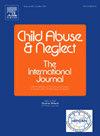预防儿童体罚:种族线索对干预信息抗拒和行为意向的影响
IF 3.4
2区 心理学
Q1 FAMILY STUDIES
引用次数: 0
摘要
儿童体罚是儿童不良经历的一种形式,需要对儿童体罚进行干预和教育。然而,针对少数种族群体的CP预防信息可能会引起对信息的抵制,因为这些信息被认为是在传达占主导地位的种族群体的意识形态,限制了父母管教孩子的自由。目的探讨CP预防信息中出现的种族线索对信息抗拒和行为意向的影响。参与者394名有10岁或10岁以下孩子的黑人父母(75%为低收入家庭,67%为母亲,Mage = 38)被随机分配观看包含相似或不同种族来源的CP预防信息。方法采用实验设计。参与者接触到CP干预信息,然后回答一份问卷。采用双向协方差分析检验了种族线索和信息格式对共情的交互作用。采用结构方程模型分析了种族线索影响CP使用意向的信息抗拒机制。结果表明,种族线索可以预测共情,从而降低心理抗拒和使用CP的意愿。收到种族来源相似信息的被试的共情程度高于收到种族来源不同信息的被试。在共情、感知自由威胁和心理抗拒的介导下,种族线索暴露与CP意图之间的关联具有统计学意义。结论基于种族的儿童虐待预防信息的有效性,为儿童虐待干预活动设计说服少数族裔家长的信息提供了依据。本文章由计算机程序翻译,如有差异,请以英文原文为准。
Preventing child corporal punishment: The influence of racial cues on intervention message reactance and behavioral intentions
Background
Child corporal punishment (CP) is a form of adverse childhood experiences (ACEs), and interventions and educational messages about CP are needed. However, CP prevention messages targeting minority racial groups can cause reactance against the message because the messages are perceived as communicating the dominant racial group's ideologies and restricting parents' freedom to discipline their children.
Objective
This study examined how racial cues presented in CP prevention messages influenced message reactance and behavioral intentions.
Participants
394 Black parents who had a child 10 years of age or younger (75 % low-income, 67 % mothers, Mage = 38) were randomly assigned to view CP prevention messages incorporating either similar or dissimilar racial source.
Methods
This study employed an experimental design. Participants were exposed to CP intervention messages and then responded to a questionnaire. Interaction effects of racial cues and message format on empathy were examined using a two-way analysis of covariance. Structural equation modeling was used to examine the message reactance mechanism through which racial cues influenced intentions to use CP.
Results
Results indicated that racial cues predicted empathy, which reduced psychological reactance and intentions to use CP. Participants, who received the message with similar racial source, reported higher empathy compared to those with a message of dissimilar racial source. The association between exposure to racial cues and CP intent were statistically significant as mediated by empathy, perceived freedom threat, and psychological reactance.
Conclusions
Results indicated the efficacy of race-tailored CP prevention messages and provided evidence for child abuse intervention campaigns to design messages to persuade parents of minority racial groups.
求助全文
通过发布文献求助,成功后即可免费获取论文全文。
去求助
来源期刊

Child Abuse & Neglect
Multiple-
CiteScore
7.40
自引率
10.40%
发文量
397
期刊介绍:
Official Publication of the International Society for Prevention of Child Abuse and Neglect. Child Abuse & Neglect The International Journal, provides an international, multidisciplinary forum on all aspects of child abuse and neglect, with special emphasis on prevention and treatment; the scope extends further to all those aspects of life which either favor or hinder child development. While contributions will primarily be from the fields of psychology, psychiatry, social work, medicine, nursing, law enforcement, legislature, education, and anthropology, the Journal encourages the concerned lay individual and child-oriented advocate organizations to contribute.
 求助内容:
求助内容: 应助结果提醒方式:
应助结果提醒方式:


